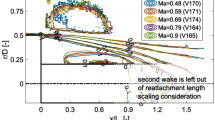Abstract
A numerical analysis of the turbulent wake flow of a generic space launcher at supersonic freestream conditions (Ma∞ = 6.0 and Re D = 1.7 × 106) is performed using a zonal RANS/LES method. To investigate the influence of various components of a rocket model on the base flow, three supported wind tunnel configurations with the same main body geometry and different aft-body extensions consisting of a blunt base, a nozzle dummy, and a full flowing underexpanded TIC nozzle (Mae = 2.52, p e/p ∞ = 100) are considered. Flow topologies for three cases are described in detail including an estimate of the impact of the wind tunnel model support on the flow field. To validate the applied numerical method, the computed flow fields are compared to experimental data from high-speed schlieren measurements provided by DLR Cologne. The influence of the used aft-body extensions on the steady-state and dynamic base flow characteristics is evaluated by a detailed analysis and comparison of the pressure distribution and its spectra along the base and nozzle walls for three investigated configurations. The numerical findings are compared to experimental wall pressure oscillation measurements provided by DLR Cologne. The major results are the non-negligible influence of the model support on the wake even on the strut averted side, the base drag reduction effect of the aft-expanding jet plume consisting of an increase of the base pressure level from \(p/p_\infty\approx0.2-0.25\) (blunt base and nozzle dummy configurations) up to \(p/p_\infty\approx0.7\) leading to a decrease of the base pressure drag coefficient from C Dp base = 0.032 to 0.012 correspondingly, and the identified dominant low-frequency modes of the base pressure oscillations at Sr D ≈ 0.05, Sr D ≈ 0.1, and Sr D ≈ 0.2 also detected in the experiments.






















Similar content being viewed by others
References
Rollstin, L.: Measurement of inflight base-pressure on an artillery-fired projectile. AIAA Paper, pp. 287–2427 (1987)
Mathur, T., Dutton, J.C.: Base-bleed experiments with a cylindrical afterbody in supersonic flow. J. Spacecr. Rockets 33, 30–37 (1996)
Bannink, W.J., Houtman, E.M., Bakker, P.G.: Base flow/underexpanded exhaust plume interaction in a supersonic external flow. AIAA Paper, pp. 98–1598 (1998)
Scarano, F., van Oudheusden, B.W., Bannink, W.J.,Bsibsi, M.: Experimental investigation of supersonic base flow plume interaction by means of particle image velocimetry. In: 5th European Symposium on Aerothermodynamics for Space Vehicles, Germany (2004)
Benay, R., Servel, P.: Two-equation k–σ turbulence model: application to a supersonic base flow. AIAA J. 39, 407–416 (2001)
Papp, J.L., Ghia, K.N.: Application of the RNG turbulence model to the simulation of axisymmetric supersonic separated base flows. AIAA Paper, pp. 2001–2027 (2001)
Forsythe, J.R., Hoffmann, K.A., Cummings, R.M., Squires, K.D.: Detached-eddy simulation with compressibility corrections applied to a supersonic axisymmetric base flow. J. Fluid Eng. 124, 911–923 (2002)
Kawai, S., Fujii, K.: Computational study of a supersonic base flow using LES/RANS hybrid methodology. AIAA Paper, pp. 2004–2068 (2004)
Fureby, C., and Kupiainen, K.: Large-Eddy simulation of supersonic axisymmetric baseflow. In: Turbulence Shear Flow Phenomenon Japan (2003)
Sandberg, R.D., Fasel, H.F.: High-accuracy DNS of supersonic base flows and control of the near wake. In: Users Group Conference, IEEE Computer Society, pp. 96–104 (2004)
Sandberg, R.D., Fasel, H.F.: Numerical investigation of transitional supersonic axisymmetric wakes. J. Fluid Mech. 563, 1–41 (2006)
Sandberg, R.D.: Numerical investigation of turbulent supersonic axisymmetric wakes. J. Fluid Mech. 702, 488–520 (2012)
Boris, J.P., Grinstein, F.F., Oran, E.S., Kolbe, R.L.: New insights into large eddy simulation. Fluid Dyn. Res. 10, 199–228 (1992)
Liou, M.S., Steffen, C.J. Jr.: New flux splitting scheme. J. Comp. Phys. 107, 23–39 (1993)
Meinke, M., Schröder, W., Krause, E., Rister, Th.: Comparision of second- and sixth-order methods for large-eddy simulations. Comput. Fluids 31, 695–718 (2002)
Fares, E., Schröder, W.: A general one-equation turbulence model for free shear and wall-bounded flows. Flow Turbul. Combust. 73, 187–215 (2004)
Roidl, B., Meinke, M., Schröder, W.: Reformulated synthetic turbulence generation method for a zonal RANS-LES method and its application to zero-pressure gradient boundary layers. Int. J. Heat Fluid Flow. doi:10.1016/j.ijheatfluidflow.2013.03.017 (2013)
Roidl, B., Meinke, M., Schröder, W.: Reformulated synthetic turbulence generation method for a zonal RANS-LES method and its application to non-zero-pressure gradient boundary layers. Int. J. Heat Fluid Flow (2013, in press)
Jarrin, N., Benhamadouche, S., Laurence, D., Prosser, R.: A synthetic-eddy-method for generating inflow conditions for large-eddy simulations. J. Heat Fluid Flow 27, 585–593 (2006)
Pamiès, M., Weiss, P.-É., Garnier, E., Deck, S., Sagaut, P.: Generation of synthetic turbulent inflow data for large eddy simulation of spatially evolving wall-bounded flows. Phys. Fluids 16, 045103 (2009)
Saile, D., Gülhan, A., Henckels, A.: Investigations on the near-wake region of a generic space launcher geometry. AIAA Paper, pp. 2011–2352 (2011)
Saile, D., Gülhan, A., Henckels, A., Glatzer, C., Statnikov, V., Meinke, M.: Investigations on the turbulent wake of a generic space launcher geometry in the hypersonic flow regime. In: Progress in flight physics. Advances in aerospace sciences EUCASS book ser. 5, pp. 209–234 (2013). doi:10.1051/eucass/201305209
Statnikov, V., Glatzer, C., Meiß, J.-H., Meinke, M., Schröder, W.: Numerical investigation of the near wake of generic space launcher systems at transonic and supersonic flows. In: Progress in Flight Physics. Advances in aerospace sciences EUCASS book ser 5, pp. 191–208 (2013). doi:10.1051/eucass/201305191
Acknowledgments
Financial support has been provided by the German Research Foundation (Deutsche Forschungsgemeinschaft – DFG) in the framework of the Sonderforschungsbereich Transregio 40. Computational resources have been provided by the High Performance Computing Center Stuttgart (HLRS).
Author information
Authors and Affiliations
Corresponding author
Additional information
This paper is based on a presentation at the German Aerospace Congress, September 10–12, 2012, Berlin, Germany.
Rights and permissions
About this article
Cite this article
Statnikov, V., Meiß, JH., Meinke, M. et al. Investigation of the turbulent wake flow of generic launcher configurations via a zonal RANS/LES method. CEAS Space J 5, 75–86 (2013). https://doi.org/10.1007/s12567-013-0045-6
Received:
Revised:
Accepted:
Published:
Issue Date:
DOI: https://doi.org/10.1007/s12567-013-0045-6




